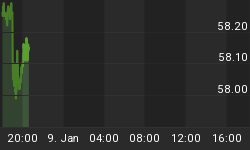How is the price of gold established? Scratching the surface, the answer seems obvious: it is a result of a free interplay of market forces. However, there is no single gold market; the yellow metal is traded in many places. Who then sets the price of gold? London or New York? Which of them shapes the price discovery process? What is the relationship between the LBMA Gold Price and Comex futures and spot prices? As the chart below shows, there is an almost perfect correlation between London and New York prices; but which leads the dance?
Chart 1: LBMA Gold A.M. Price (green line) and Comex Closing Spot Price (red line) in 2015.
Few scientific studies have tried to answer who leads in this dance. Lucey et al. (2012) looked at the gold prices (London A.M. fixing and Comex spot closes) from January 1986 through the end of July 2012, and found that neither of them is dominant in terms of price information shares. What is more, there is no clear evidence that either market is dominated by the other. The average share of the price discovery for London is 45-55 percent, depending on the method used. London and New York form a bi-polar world and their prices are interdependent. Interestingly, researchers also found that the share of price discovery is unstable, depending on the circumstances (for example, London was the dominant marketplace during the collapse of the Soviet Union, the 1992 Exchange Rate Mechanism crisis and Lehman Brothers event, while New York dominated after the start of the Ruble Crisis and 9/11 attacks).
Hauptfleisch et al. (2015) on the other hand decided to use intraday data on gold prices in London and the OTC market and the U.S. futures market from 1997 to 2014. They found that although the volume of gold traded in New York is less than a tenth of the London spot volume, "the futures market tends to play a more important role in incorporating new information about the value of gold". Comex's dominance was strengthened in 2006 when it introduced the fully electronic, nearly 24-hour Globex platform. Since then, Comex leads throughout the day irrespective of market hours (prior to the Globex move, it was London that dominated during the U.K. daylight hours).
As we can see, volume alone is not as important as market structure. Futures market gives investors, speculators and hedgers have the advantage of spot trading. The majority of volume is traded in the London OTC market, but because of lack of price and transactions' transparency, the majority of price discovery happens in NY. Futures markets are more transparent, highly liquid and enable investors to make transactions faster, with leverage or options - not to involve physical delivery. Thanks to these features, futures markets are the fastest to react to new information, quickly incorporating it into the gold prices. They are so effective that the gold spot price is actually derived from future prices (it is a bit counterintuitive, since the futures prices are in theory determined using the commodity's spot price, the risk free rate, time to maturity of the contract and other factors, such as costs associated with storage or convenience premium). In practice the spot price (theoretically, an immediate price with settlement in two business days) is determined by the most recent month futures contract with the most volume.
Let's repeat again: the 'gold spot price' is neither the price quoted in the last physical trade, nor the current market price of physical bullion, nor the LBMA Gold Price, as some investors think. The spot price is the net present value of the future price in the nearest month, while LBMA Gold Price is a snapshot of gold prices quoted by traders in the London OTC spot market in the wholesale transactions. To make matters worse, the 'real spot price', i.e. price offered by bullion dealers, is yet another price, different from the 'Comex spot' or London fix. Bullion dealers usually quote prices higher than fix, since they bear higher costs than wholesale players and add some markup to make a profit.
The key takeaway is that although the gold market is theoretically global, in practice it remains bi-polar, with the dominant role of the U.S. futures markets in the price discovery process. It does not prove manipulation, but rather the higher efficiency of the public and centralized futures market compared to non-transparent and decentralized OTC market. This finding has important investment implications. Investors may like or not, but the price of gold is mainly set in New York. It means that Comex participants and their positioning decisions decide on the price of gold.
Thank you.
If you enjoyed the above analysis and would you like to know more about the structure of the gold market, we invite you to read the March Market Overview report. If you're interested in the detailed price analysis and price projections with targets, we invite you to sign up for our Gold & Silver Trading Alerts. If you're not ready to subscribe at this time, we invite you to sign up for our gold newsletter and stay up-to-date with our latest free articles. It's free and you can unsubscribe anytime.















